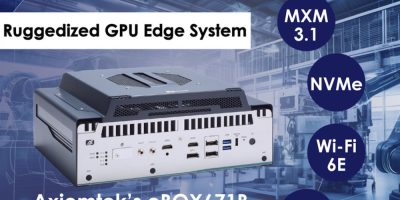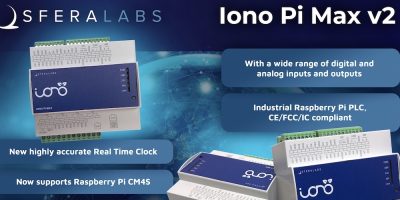Axiomtek has unveiled the eBOX671B, a fanless edge computing system that offers optimal data transferring with 2.5GbE LAN ports, cellular 5G module, and Wi-Fi 6 module support for edge computing in industrial automation. With its compatibility with MXM 3.1 Type A GPU cards, the eBOX671B can effectively accommodate up to five display outputs, ensuring optimised performance for various display requirements. Designed to operate reliably in industrial environments, the IP40-rated embedded system features a wide operating temperature of -40°C to +65°C, 3 Grms vibration resistance, and a 9 to 36 VDC power input. The eBOX671B is well-suited for various industrial automation applications such as edge controllers, embedded controllers, machine vision, OT servers, robotics, and more.
The eBOX671B is powered by the 13th/12th gen Intel® Core™ i9/i7/i5/i3 and Celeron® processors with Intel® R680E chipset (codename: Alder Lake S). The reliable eBOX671B comes with two 262-pin DDR5-4800 SO-DIMM slots with up to 64GB of system memory. Two 2.5” SATA HDD/SSD (RAID 0,1 supported) drive bays, one NVMe through M.2 Key M 2280 slot, and one mSATA are available for extensive storage needs. Up to five display outputs are enabled via two HDMI 1.4b, one DisplayPort 1.4a, and two DisplayPort 1.4a via an optional MXM module kit. The eBOX671B also offers great expansion interfaces with one full-size PCI Express Mini Card slot, one M.2 Key M 2280 socket for storage, one M.2 Key E 2230 socket for Wi-Fi 6E, and one M.2 Key B 3052 socket for 5G connectivity. Plus, one front-access SIM slot with cover (through M.2 Key B) and one internal SIM slot for PCIe Mini Card slot are available.
To achieve higher graphics performance, customers can install the MXM GPU onto the eBOX671B within the existing system footprint without increasing the system size, saving time, effort, and money. To optimise system performance and speed up deployment, the rugged eBOX671B can easily enhance its overall efficiency and effectiveness through an optional fan kit and a flexible I/O window supported by mPCIe modules. It is also equipped to facilitate high-speed NVMe storage, leading to a decrease in latency,” said Jason Kao, product manager of AIoT Division at Axiomtek. “Axiomtek’s eBOX671B continues the system design of the series so customers can easily upgrade. In addition, the eBOX671B utilises the Trusted Platform Module 2.0 (TPM 2.0) function onboard to ensure data and network security.”
The edge computing system is equipped with rich I/O interfaces, including two RS-232, two RS-232/422/485 with autoflow, four USB 3.2 Gen2 ports, two USB 3.2 Gen1 ports, three 2.5GbE LAN ports, and one GbE LAN port. Other interfaces include one remote power switch, one grounding screw, and five antenna openings. Besides, this powerful computing embedded system supports Windows 11 IoT, Windows 10 IoT, and Linux.







